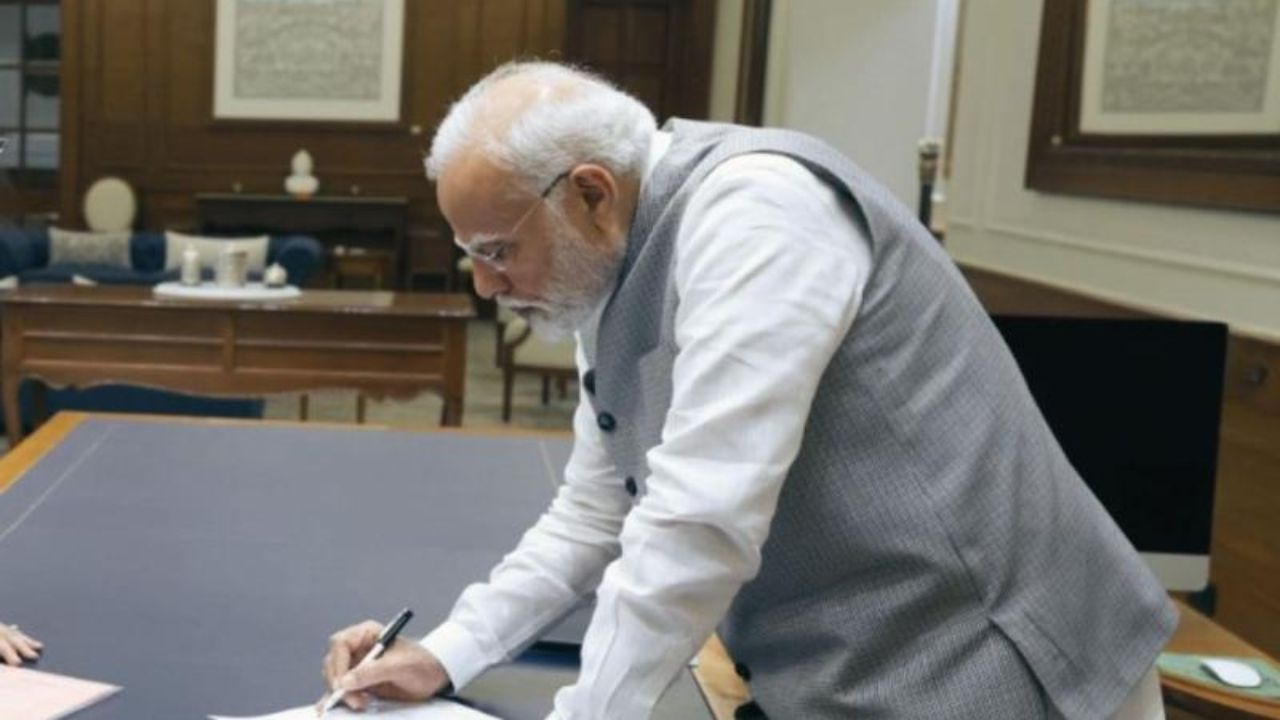PM Modi at HTLS 2024: ‘Trust Restored in Government,’ 2047 Roadmap Unveiled
Outlining his vision and road map for making India a developed nation by 2047, Prime Minister Narendra Modi on Saturday underlined public confidence in the government.

PM Modi at HTLS 2024: Outlining his vision and road map for making India a developed nation by 2047, Prime Minister Narendra Modi on Saturday underlined public confidence in the government, the belief of the ordinary citizen and a transformation of the social mindset as crucial propellers in this journey.
Prime Minister Narendra Modi addressed the 22nd Hindustan Times Leadership Summit as its chief guest, terming the hundredth year of Hindustan Times a historic milestone and saying that the newspaper was inaugurated by Mahatma Gandhi in 1924 and released a commemorative postage stamp on this grand event.
He spoke of the National Democratic Alliance government record in deliverability of public goods and welfare benefits, rejection of vote bank politics, reinstatement of the citizens' confidence into the administration, and giving the administration a higher purpose: attainment of developed country status by the centenary of India's independence, August 15, 1947.
Also Read: Pushpa 2: The Rule Trailer Featuring Allu Arjun Takes Excitement to New Heights
He spoke about the mantra of investment for employment, development to dignity and of spending big on the people and saving big for the people. He called Indians out to work towards changing the social mindset and accept nothing but world-class standards.
“We have made a long journey. From the freedom struggle to the aspirations of a post-independence India, this is an extraordinary and wonderful journey… and the people who have showed India the way forward are the ordinary citizen, and her capacity and sagacity,” Modi said.
“There is a thinking and an expectation that the 21st century will be India’s century. But for this to happen, we have to work rapidly and make more effort. We are working hard towards that mission,” he added.
He gave examples to illustrate what his government had contributed to India's development journey, and how it increased the capacity and trust of ordinary citizens, and their risk-taking ability.
He said that at one time, experts spoke how good economics is bad politics, and that helped cover the inefficiency of governments, and their vote bank politics.
“This created imbalance and inequality. Development was only on boards but couldn’t be seen on the ground. This model broke the citizen’s trust in government. We brought that belief back and gave a purpose to governance,” he said.
It said the mantra of his administration was progress of the people, by the people, and for the people. “And our purpose is to make a new India, a developed India. And when we embarked on this goal, citizens have reposed their trust in us,” he added. “When public confidence and self-confidence rise, an incredible impact is seen on national development.”
He said that the common thread between early civilizations and modern developed countries is the presence of a risk-taking culture. He said that ancient India was a hot spot of global commerce, with business interests stretching from South-east Asia to the Arab world and Rome.
“After independence, we had to boost this risk-taking culture. But governments at the time didn’t give the citizens confidence. So the culture of one step forward and two steps back became entrenched. Only in the last decade has risk-taking got new energy.”
He pointed to how the number of startups has ballooned to now over 125,000; young men and women in small-town India are taking up the sport and bringing glory to the nation and self-help groups have ensured 100 million lakhpati didis.
Also Read: 5 Naxalites Killed, 2 Jawans Injured in Intense Encounter in Chhattisgarh’s Bastar Region
“I spoke to a woman in the village who bought a tractor and generated income for her whole family. She took risks. She showed that when the poor and middle-class take risks, change is visible,” he added.
To prove his investment for employment, development to dignity mission, Modi applied a few examples. The first one was that of the toilet-building mission wherein he said, not only many people are being provided with security and dignity but also there is a guarantee that it will create employment opportunities at local levels. The second effort was done by the government: expanding the use of LPG cylinders that increased from 140 million in 2014 to 300 million in 2024.
“There was a time when you had to get a letter from an MP for a cylinder. If someone had a gas cylinder, he was a big man. Governments would debate whether six or nine cylinders should be given. But we didn’t enter that debate. We didn’t allow any shortage of gas by building supporting infrastructure and investing in them. It generated income.”
“Earlier, the poor could only dream of having a credit or debit card in their pocket. But Rupay has fulfilled that dream. The guy who alights from a rich car uses the same UPI that a food cart vendor uses. That has boosted self-respect. This is investment to employment, development to dignity,” he said.
According to Modi, another major approach of his government was spends big for the people and save big for the people. He said the Union Budget has increased from ₹16 lakh crore in 2014 to ₹48 lakh crore today, and capital expenditure from ₹2.25 lakh crore to ₹11 lakh crore, and this amount is being utilised to make new hospitals, schools, roads, railways, and research facilities.
He said plugging leakage through direct benefit transfer had saved people ₹3.5 lakh crore, free health care under the Ayushman Bharat scheme saved ₹1.1 lakh crore, subsidised medicines under the Jan Aushadi scheme saved ₹30 lakh crore, subsidised stents, and knee implants saved thousands of crores, Ujala schemes saved ₹20,000 crore in electricity bills, Swachh Bharat reduced illnesses and saved ₹50,000 per family, toilets saved ₹70,000 per family according to Unicef, and free piped drinking water saved ₹10,000 per family for 120 million people, according to the World Health Organisation.
“Ten years ago, no one had thought such a transformation was possible in India. This success has inspired us to dream bigger,” he said.
Processes have to be improved, products improvised to make them world-class, from construction and infrastructure to education and entertainment. “This approach has to be relentlessly maintained among the public. And HT has a big role to play in this mission.”
Also Read: Rohit Sharma and Ritika Sajdeh Welcome Baby Boy; India Captain to Join Perth Test
For breaking news and live news updates, like us on Facebook or follow us on Twitter and Instagram. Read more on Latest Politics News on The National Bulletin


